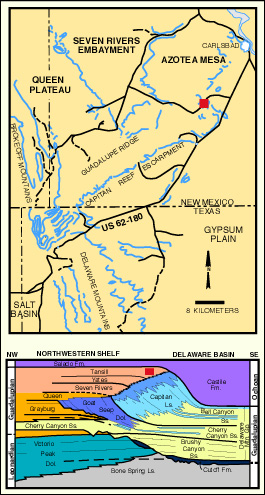
Permian Reef Complex Virtual Field Trip
Stop III-2: Tansill Near-Back-Reef Facies

This locality (equivalent to part of Dunham's (1972) Stop I-1) exposes dolomites and calcitic dolomites of the near-back-reef Tansill Formation. A wide variety of sediment types are present here, typical of the complex, small-scale microfacies patterns in this paleogeographic zone. We can see pisolitic packstones, birdseye dolomites, cross-bedded to massive green-algal grainstones (some of which look deceptively like mudstones), fenestral dolomites with tepee-structures, and other lithologies intimately intermingled at this site. Fusulinid Foraminifera, belerophontid gastropods, pelecypods, green algae, and probable blue-green algae are particularly abundant in these strata.

© Peter A. Scholle, 1999

© Peter A. Scholle, 1999
These beds apparently represent a series of migrating islands or banks with shallowing upward sequences (Mazzullo et al., 1989; Parsley and Warren, 1989; Scholle, 1980). The cross-bedded grainstones (see photo) represent basinward beach deposits; the fenestral (birdseye) dolomites (see photo) represent leeward subaerial and intertidal flats, the pisolitic packstones to wackestones likely reflect subtidal restricted or sheltered sediment accumulation sites; the massive fossiliferous packstones and grainstones may have formed in intervening tidal channels and unrestricted subtidal areas; and the tepee dolomites found near the top of the section probably represent exposure surfaces which cap the sequence. These facies patterns are quite similar to ones found in the Bahamas in regions such as Joulter's Cay, or in the barrier-lagoon complexes of the Persian Gulf.
Diagenetically, these Permian microfacies are equally complex. Aphanocrystalline dolomitization is quite extensive, especially in the peritidal and supratidal facies. Associated lobate and partitioned vugs clearly represent leached and/or calcitized early-diagenetic nodular evaporites. Note the close association between the areas of such evaporite vugs and dolomitization — both probably result from early reflux of evaporitic brines from more shelfward hypersaline lagoons.

© Peter A. Scholle, 1999

© Peter A. Scholle, 1999
In addition, one can find (most easily using a microscope) examples of aragonitic submarine cement as well as vadose and phreatic meteoric calcite cements (see photo above and photo nearby). Selective leaching of bioclasts is common in this setting, producing moldic fabrics (see photo). Porosities in this zone are variable, but include some of the highest values found anywhere in the Guadalupian facies spectrum. Subsurface equivalents of this facies suite host large volumes of oil (see photo).

© Peter A. Scholle, 1999
More modern diagenesis is also apparent at this outcrop. The cave system in the center of the outcrop, and the solution-enlarged, calcite-filled fracture systems associated with it, were probably produced by the same Tertiary hydrologic system which formed Carlsbad Caverns. This late-stage meteoric water flow was also responsible for leaching or calcitization of precursor evaporites which can be seen with increasing frequency from this locality landward.
Turn around and return to the main road.
Return to Dark Canyon-Sitting Bull Falls-Rocky Arroyo Roadlog


